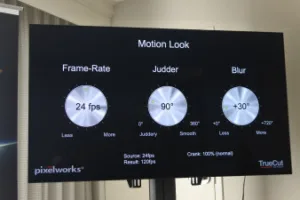In December, the famed video processing company Pixelworks introduced TrueCut software, and at CES 2022 announced a partnership with TCL. TCL’s 98-inch TV introduced at CES will support TrueCut.

At a meeting in the company’s suite near the Las Vegas Convention Center, Pixelworks’s EVP of Technology Richard Miller called TrueCut “game breaking.” The software platform “addresses motion at the fundamental level for camera through to the display,” said Miller.
Judder, blur, and the traditional frame rate of 24 frames per second are prized by film directors and directors of photography for providing a “filmic look.” The smooth and sharp video of television is called the “soap opera look,” and it is not a compliment. The traditional levels of frame rate, blur, and judder may look just as the director intended on the large, not-very-bright-images shown in a darkened theater, but judder and blur are amplified as the image gets brighter and screens get larger. In short, the same judder that looks appropriate in a cinema looks excessive — and sometimes unwatchable, said Miller — on bright TV sets.
The challenge PixelWorks took on was to make movies consistently reflect the creators’ intent across all platforms, from cinema to cell phones — consistent. TrueCut provides film makers with tools for motion grading that are analogous to those for to color grading. Their time shutter acts as a virtual camera in post production. Frame rate and judder can be freely adjusted to map motion such that the film makers’ intent is mapped to each display. (Chris wrote about this on the production side back in 2019 – HFR is Not a Dirty Word – At Least it Shouldn’t be and Matt followed it up with Frame Rate, HDR and Creative Intent – Chris also did a ‘deeper dive’ white paper (registration required) — editor)
The tools permit all content to be filmed at high frame and tuned down to whatever frame rate — 24, 48, 60, or something else — provides the intended filmic look on any playback platform. The adjustment can be done scene by scene, as is done in dynamic tone mapping. The goal is to make the video look filmic on any platform but not excessive. Demos Miller showed me with various levels of judder and blur were convincing.
The TrueCut software platform allows a film’s creators to adjust frame rate, judder, and blur independently for each scene, with goal of delivering the creators’ intent consistently on any platform, from phone to cinema. (Photo: Ken Werner) Click for higher resolution
At least six TrueCut six films have been released so far, and the technology has already won multiple industry awards, said Miller.
TrueCut software must be applied to the TV set as well. Among other things the software turns of the TV’s motion smoothing for TrueCut-processed material since all smoothing is done at the source. Size and brightness amplify judder. It also turns off film maker mode because this mode makes the screen darker. The TCL 98-inch introduced at CES incorporates these features.
It may be that you will soon look for the TrueCut logo on you new TV, along with the logos for Dolby Vision and UHD. (KW)
Ken Werner is Principal of Nutmeg Consultants. He consults on display issues for attorneys, investment analysts, and companies using displays in their products. He is the 2017 recipient of the Society for Information Display’s Lewis and Beatrice Winner Award. You can reach him at [email protected].

